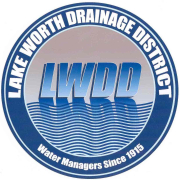LWDD Helps Save Water
LWDD Helps Save Water
Florida benefits from an average annual rainfall exceeding fifty inches, with most of this precipitation occurring during the six-month rainy season spanning from May to mid-October. While some of the runoff generated from these rains is directed towards the ocean to prevent flooding, a considerable volume permeates the ground, replenishing the freshwater aquifers that serve as a source for our drinking water, lakes, and wetlands.
An extensive regional water management system is essential to ensure the safety and well-being of large populations in South Florida. This system must effectively balance the water supply demands of urban areas and agricultural activities while simultaneously fulfilling the obligations of flood protection.
Groundwater levels tend to decline gradually during drought due to reduced rainfall and elevated evaporation rates. In such instances, regional water managers seek additional water sources, such as the Water Conservation Areas in the Everglades or Lake Okeechobee. Water from these vital reserves is introduced into the canal network to elevate water levels. This process fosters water infiltration through sandy soils, facilitating groundwater recharge and restoring the groundwater table to its standard elevation, safeguarding drinking water supplies.
Inadequate drainage could compromise public health and safety and lead to flooding and significant property damage. Conversely, improper maintenance of regional groundwater levels could impede the functionality of wellfields, preventing them from supplying water to residential and commercial entities. In severe scenarios, the inland migration of saltwater from the ocean could irreversibly contaminate the drinking water supply, rendering it unsafe for consumption.
The Lake Worth Drainage District’s (LWDD) water conservation initiatives play an integral role in addressing the water supply challenges our region faces. The extensive network of LWDD canals is pivotal in regulating groundwater levels and supporting the hydrological levels of lakes, ponds, and wetlands throughout the area.
The LWDD’s commitment to managing drainage canals at optimal elevations, reconciling water supply requirements, and minimizing ocean discharges whenever feasible is essential to a comprehensive approach to water conservation in South Florida.




